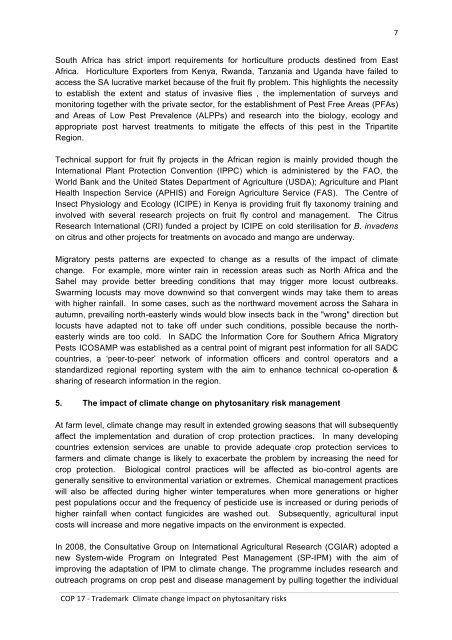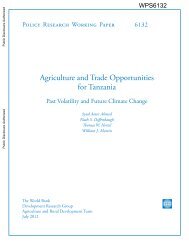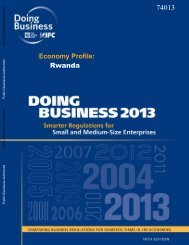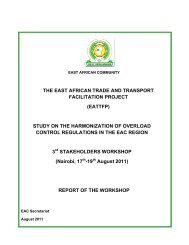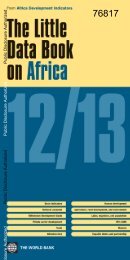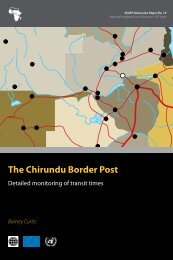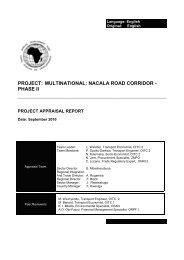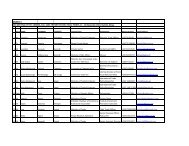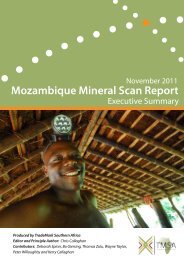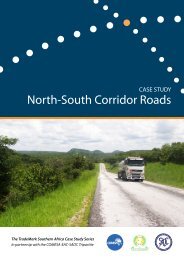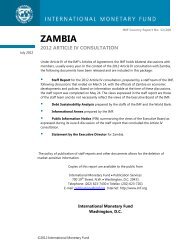Plant Health, Climate Change and Trade - TradeMark Southern Africa
Plant Health, Climate Change and Trade - TradeMark Southern Africa
Plant Health, Climate Change and Trade - TradeMark Southern Africa
Create successful ePaper yourself
Turn your PDF publications into a flip-book with our unique Google optimized e-Paper software.
7 <br />
South <strong>Africa</strong> has strict import requirements for horticulture products destined from East<br />
<strong>Africa</strong>. Horticulture Exporters from Kenya, Rw<strong>and</strong>a, Tanzania <strong>and</strong> Ug<strong>and</strong>a have failed to<br />
access the SA lucrative market because of the fruit fly problem. This highlights the necessity<br />
to establish the extent <strong>and</strong> status of invasive flies , the implementation of surveys <strong>and</strong><br />
monitoring together with the private sector, for the establishment of Pest Free Areas (PFAs)<br />
<strong>and</strong> Areas of Low Pest Prevalence (ALPPs) <strong>and</strong> research into the biology, ecology <strong>and</strong><br />
appropriate post harvest treatments to mitigate the effects of this pest in the Tripartite<br />
Region.<br />
Technical support for fruit fly projects in the <strong>Africa</strong>n region is mainly provided though the<br />
International <strong>Plant</strong> Protection Convention (IPPC) which is administered by the FAO, the<br />
World Bank <strong>and</strong> the United States Department of Agriculture (USDA); Agriculture <strong>and</strong> <strong>Plant</strong><br />
<strong>Health</strong> Inspection Service (APHIS) <strong>and</strong> Foreign Agriculture Service (FAS). The Centre of<br />
Insect Physiology <strong>and</strong> Ecology (ICIPE) in Kenya is providing fruit fly taxonomy training <strong>and</strong><br />
involved with several research projects on fruit fly control <strong>and</strong> management. The Citrus<br />
Research International (CRI) funded a project by ICIPE on cold sterilisation for B. invadens<br />
on citrus <strong>and</strong> other projects for treatments on avocado <strong>and</strong> mango are underway.<br />
Migratory pests patterns are expected to change as a results of the impact of climate<br />
change. For example, more winter rain in recession areas such as North <strong>Africa</strong> <strong>and</strong> the<br />
Sahel may provide better breeding conditions that may trigger more locust outbreaks.<br />
Swarming locusts may move downwind so that convergent winds may take them to areas<br />
with higher rainfall. In some cases, such as the northward movement across the Sahara in<br />
autumn, prevailing north-easterly winds would blow insects back in the "wrong" direction but<br />
locusts have adapted not to take off under such conditions, possible because the northeasterly<br />
winds are too cold. In SADC the Information Core for <strong>Southern</strong> <strong>Africa</strong> Migratory<br />
Pests ICOSAMP was established as a central point of migrant pest information for all SADC<br />
countries, a ‘peer-to-peer’ network of information officers <strong>and</strong> control operators <strong>and</strong> a<br />
st<strong>and</strong>ardized regional reporting system with the aim to enhance technical co-operation &<br />
sharing of research information in the region.<br />
5. The impact of climate change on phytosanitary risk management<br />
At farm level, climate change may result in extended growing seasons that will subsequently<br />
affect the implementation <strong>and</strong> duration of crop protection practices. In many developing<br />
countries extension services are unable to provide adequate crop protection services to<br />
farmers <strong>and</strong> climate change is likely to exacerbate the problem by increasing the need for<br />
crop protection. Biological control practices will be affected as bio-control agents are<br />
generally sensitive to environmental variation or extremes. Chemical management practices<br />
will also be affected during higher winter temperatures when more generations or higher<br />
pest populations occur <strong>and</strong> the frequency of pesticide use is increased or during periods of<br />
higher rainfall when contact fungicides are washed out. Subsequently, agricultural input<br />
costs will increase <strong>and</strong> more negative impacts on the environment is expected.<br />
In 2008, the Consultative Group on International Agricultural Research (CGIAR) adopted a<br />
new System-wide Program on Integrated Pest Management (SP-IPM) with the aim of<br />
improving the adaptation of IPM to climate change. The programme includes research <strong>and</strong><br />
outreach programs on crop pest <strong>and</strong> disease management by pulling together the individual<br />
COP 17 -‐ <strong>Trade</strong>mark <strong>Climate</strong> change impact on phytosanitary risks


